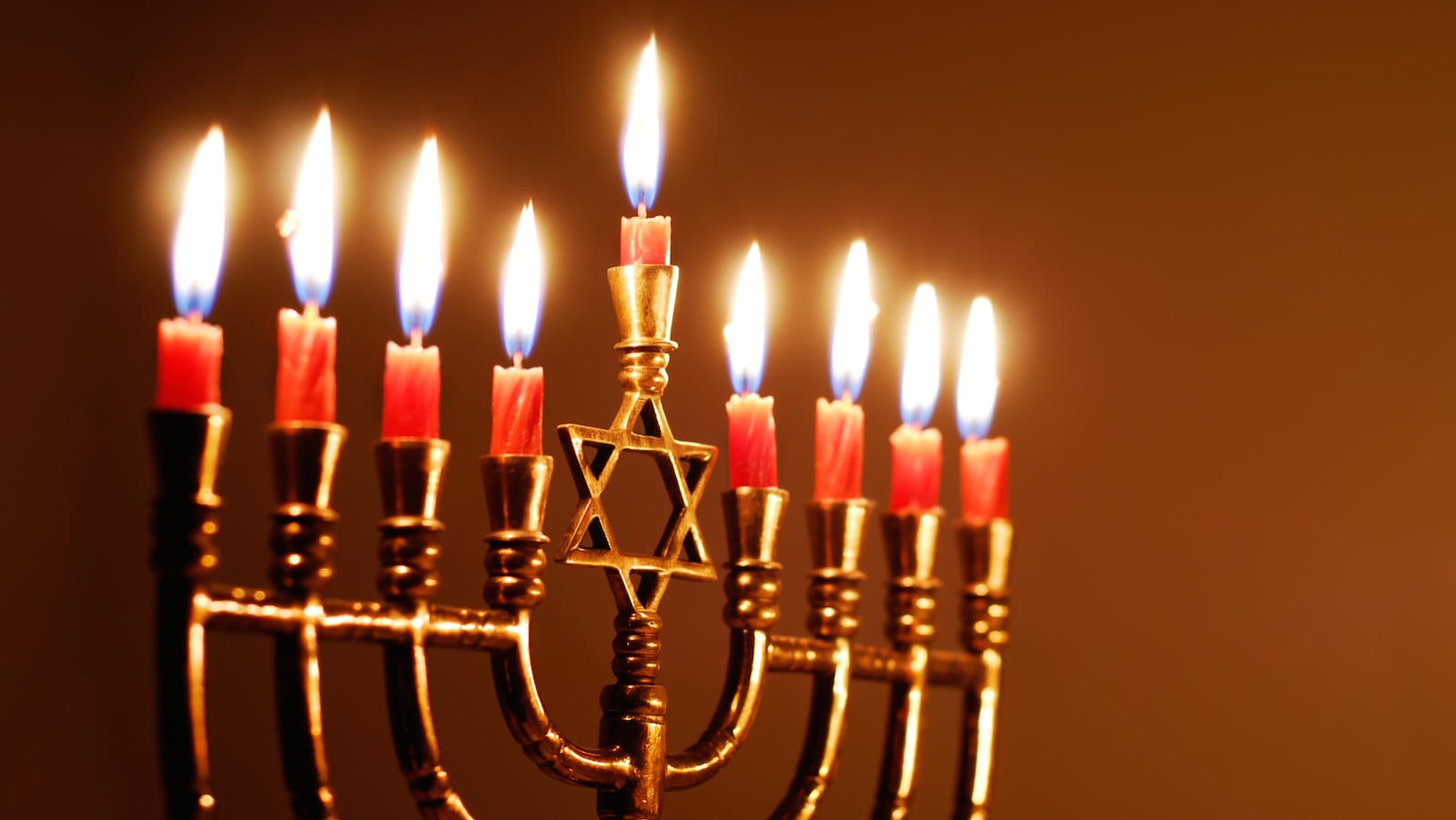The Baraita from Babylonian Talmud Shabbat 21bOur sages taught: The mitzvah of Hanukkah is a candle for a man and his household, and those who enhance (mehadrin): a candle for each person. And those who really enhance (mehadrin min hamehadrin): Bet Shammai says: On the first day one lights eight and from then on one continues to decrease, and Bet Hillel says: On the first day one lights one and from then on one continues to increase.
Our sages taught: The mitzvah of Hanukkah is a candle for a man and his household, and those who enhance (mehadrin): a candle for each person. And those who really enhance (mehadrin min hamehadrin): Bet Shammai says: On the first day one lights eight and from then on one continues to decrease, and Bet Hillel says: On the first day one lights one and from then on one continues to increase.
This baraita lays out four different ways of observing the lighting of Hanukkah candles. The basic obligation is for an individual to light one candle on each night on behalf of the household. The baraita then introduces the term mehadrin; one who performs an enhancement, an act of hiddur, extends the obligation to each individual in the household, so that on each night of Hanukkah, a family with four people would light four candles.
The highest level of enhancement envisioned by the baraita is the mehadrin min hamehadrin, those who really enhance (or “who enhance upon the enhancement of”) the mitzvah, light a different number of candles each night, either decreasing from eight to one, according to Bet Shammai (the school of Shammai), or increasing from one to eight, according to Bet Hillel (the school of Hillel).
It is tempting to see the different ways of lighting as historical developments, especially since now everyone lights according to Bet Hillel’s understanding of the most enhanced opinion. Nevertheless, although enhancements to this observance were added by later generations, it is not necessary to assume that the baraita itself reflects such a development. It is enough to note the two different ways in which enhancement was envisioned: (1) by extending the number of people who participated in the lighting, and (2) by extending the number of candles that were lit.
The Talmud, as is its wont, does not let the controversy between Bet Shammai and Bet Hillel stand unanalyzed. Indeed, two different Amoraim (rabbinic sages from the third-sixth centuries) each present an interpretation of the conflict.
With your help, My Jewish Learning can provide endless opportunities for learning, connection and discovery.
The Comments of the Amoraim, Babylonian Talmud Shabbat 21b
Ulla said: Two Amoraim in the West (the Land of Israel) disagreed [on how to explain this disagreement between Bet Hillel and Bet Shammai, namely] R. Yossi bar Abin and R. Yossi bar Zevida. One said: The reason for Bet Shammai was according to the number of days left and the reason for Bet Hillel was according to the number of days that have passed. And one said: The reason for Bet Shammai was according to the number of bulls offered up on Sukkot, and the reason for Bet Hillel was that we increase in holiness and we don’t decrease.
The first Rabbi Yossi’s opinion explains that Bet Shammai counted the number of days left (including the current day), so that at the beginning of the third night of Hanukkah, there would be six full days left, while Bet Hillel counted the days that had passed, again including the current day.
The second Rabbi Yossi, however, adds a second set of reasons. Bet Shammai applied the precedent of the number of bulls that were offered in the Temple on each successive day of the holiday of Sukkot, which decreased from thirteen on the first day to seven on the last day. Bet Hillel applied a much broader principle, namely that holiness should only increase and not decrease, even symbolically.
If two approaches exist in the Talmud, the anonymous editor of the Talmud usually asks, “How do they differ in practice?” In this instance, however, there is no effort made to indicate how the two different Rabbi Yossis might apply Bet Shammai’s and Bet Hillel’s approaches differently.
So why is there a second set of reasons? Perhaps the second Rabbi Yossi was engaging in a third kind of enhancement that does not increase the number of people performing the mitzvah nor how it is performed, but rather, how it is understood. By associating Hanukkah with Sukkot and the candles with the burnt offerings of the latter festival, and by expressing the idea of increasing holiness as the candles increase, the act of lighting candles and Hanukkah as a whole are enhanced.
Really Enhancing or Enhancing the Enhancement
It is not clear what exactly is meant by the term mehadrin min hamehadrin. Are the approaches of Bet Hillel and Bet Shammai just a different way of doing the lighting, or are they an extension of the first enhancement of extending who was to light the candles? The Tosafot, the Ashkenazic commentators on the Talmud, and specifically Rabbenu Isaac of Dampierre (near Troyes, France), a 12th-century commentator, maintained the former approach.
Tosafot Shabbat 21b s.v. Vehamehadrin min hamehadrin
It appears to Rabbenu Isaac that Bet Shammai and Bet Hillel only apply to [the case of] ‘a candle for a man and his household’, for that way there is more enhancement because there is visual recognition (hekera) when one continues to add on or subtract according to the days that are left or which have passed. But if one does ‘a candle for each person,’ even if one increases from then on, there is no visual recognition because people would think that that is [due to] how many people there are in the house.
According to Rabbenu Isaac, the crucial element is the concept of visual recognition; someone walking by the window should see the candles and associate the number of flames with the day of the holiday. If each individual were to light candles corresponding to the number of the day, the viewer might become confused. In this way, the Tosafot have again added a different cognitive element to the observance—visual recognition—and have more thoroughly integrated the concept of pirsum ha-nes (publicizing the miracle) into the observance of candle lighting.
It should be noted that in this period, Hanukkah candle lighting was still done with individual oil lamps. Although some historians claim that lamps with eight wells of oil originated in early times, there is no solid evidence for a Hanukkah candelabrum until several centuries after the Tosafot.
At about the same time as Rabbenu Isaac, Maimonides, the Sephardic author of the Mishneh Torah, took the opposite approach:
Rambam, Mishneh Torah, Hilkhot Hanukkah 4:1-2
And one enhances even more than this and does the most preferred form of the mitzvah:one lights one candle for each person on the first night and continues to add one candle each night. How is this? If there were 10 people in the house on the first night he would light ten candles and on the second night twenty and on the third night thirty until he is found on the eighth night lighting eighty candles.
Maimonides does not refer to the Ashkenazic innovation of the concept of visual recognition. His model of hidur, builds upon the first enhancement that includes each individual, and seems to focus on the increasing illumination of the light. Eighty candles grouped all together are certainly visible in the darkest winter night.
More Is Not Always Better
Joseph Caro, the Sephardic author of the 16th-century code of law, the Shulchan Aruch, frequently follows his Sephardic forbearer, Maimonides. On the issue of lighting Hanukkah lights, however, Caro rejects Maimonides and restates the approach of the Ashkenazi Tosafot in order to maintain the concept of visual recognition. Caro’s approach demonstrates that an enhancement does not require more candles or people. By following the Ashkenazi approach, Caro adopted an interpretation that may have been new for his Sephardic community, perhaps for the very purpose of doing something new.
Moses Isserles, the Ashkenazi rabbi whose glosses and comments completed the Shulhan Arukh, however, does not simply follow Caro’s lead and adopt the approach of his Ashkenazi forebears. Isserles also innovates and creates a new synthesis:
Isserles in Shulchan Aruch, Orah Hayyim, 671:2
And there are those who say that each member of the household lights, and this is the widespread custom, but each person should be careful to light his/her candles in a distinct place in order that there be visual recognition of how many candles one is lighting.
For Maimonides, eighty candles were lit all together. For Moses Isserles, the sets of eight candles were lit in distinct places (makom meyuchad) where the sets of candles would be seen as a unit, maintaining visual recognition of the night of the holiday. It was this innovative synthesis that led to the creation of the Hanukkah candelabrum, the Hanukkiyah, which is used today.
The irony inherent in having later Ashkenazi authorities adopt Sephardi customs and vice versa did not escape the notice of later rabbis. The 17th century Ukrainian Rabbi David ben Shmuel ha-Levi noted:
And in this there is an innovation in practice in that the Sephardim behave according to Tosafot and the Ashkenazim behave according to Maimonides, and this we have not found in other places.
Perhaps Caro and Isserles present yet another model for enhancement. By reclaiming the customs of different Jewish communities and integrating them into their current practice, Caro and Isserles enhanced their own communities’ observance of Hanukkah.
Explore Hanukkah’s history, global traditions, food and more with My Jewish Learning’s “All About Hanukkah” email series. Sign up to take a journey through Hanukkah and go deeper into the Festival of Lights.
Ashkenazi
Pronounced: AHSH-ken-AH-zee, Origin: Hebrew, Jews of Central and Eastern European origin.
Hanukkah
Pronounced: KHAH-nuh-kah, also ha-new-KAH, an eight-day festival commemorating the Maccabees' victory over the Greeks and subsequent rededication of the temple. Falls in the Hebrew month of Kislev, which usually corresponds with December.
mitzvah
Pronounced: MITZ-vuh or meetz-VAH, Origin: Hebrew, commandment, also used to mean good deed.
Sephardic
Pronounced: seh-FAR-dik, Origin: Hebrew, describing Jews descending from the Jews of Spain.
Shabbat
Pronounced: shuh-BAHT or shah-BAHT, Origin: Hebrew, the Sabbath, from sundown Friday to sundown Saturday.
Sukkot
Pronounced: sue-KOTE, or SOOH-kuss (oo as in book), Origin: Hebrew, a harvest festival in which Jews eat inside temporary huts, falls in the Jewish month of Tishrei, which usually coincides with September or October.
Talmud
Pronounced: TALL-mud, Origin: Hebrew, the set of teachings and commentaries on the Torah that form the basis for Jewish law. Comprised of the Mishnah and the Gemara, it contains the opinions of thousands of rabbis from different periods in Jewish history.



